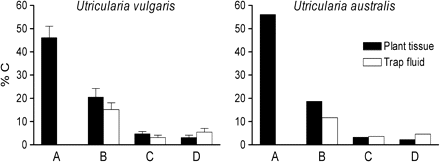 The rootless, aquatic Utricularia species belong to the largest and most cosmopolitan carnivorous plant genus. Populations of Utricularia plants are an important component of many standing, nutrient-poor, and humic waters. Carbon (C) allocation is an aspect of Utricularia’s ecophysiology that has not been studied previously and there is considerable uncertainty about the functional and ecological benefit of the trap-associated microbial community and the potential role played by C exudation in enhancing plant–microbe interactions. A 13C-labelling experiment was conducted in greenhouse conditions to determine the C allocation between plant tissues of increasing age and trap fluid in two Utricularia species. Both species allocated a majority of the newly fixed C into the fast growing shoot apex (46.1±8.6% in U. vulgaris and 56.1% in U. australis). Carbon allocation rapidly decreased with increasing age of the shoot, constituting only 8.0±4.0% and 6.7% of the total newly fixed C in the oldest analysed segments in U. vulgaris and U. australis, respectively. In the trap-bearing shoot segments, the ratio of C exuded into the trap fluid to that in plant tissues increased markedly with age—in the oldest analysed segments twice as much newly fixed C was allocated into the trap fluid than the plant tissue. Overall, a significant amount of the newly fixed C, approximately 25% (U. vulgaris) and 20% (U. australis), was allocated to the trap fluid. The importance of C exudation for the development of the microbial community associated with the traps as well as for the growth and ecology of aquatic Utricularia is discussed.
The rootless, aquatic Utricularia species belong to the largest and most cosmopolitan carnivorous plant genus. Populations of Utricularia plants are an important component of many standing, nutrient-poor, and humic waters. Carbon (C) allocation is an aspect of Utricularia’s ecophysiology that has not been studied previously and there is considerable uncertainty about the functional and ecological benefit of the trap-associated microbial community and the potential role played by C exudation in enhancing plant–microbe interactions. A 13C-labelling experiment was conducted in greenhouse conditions to determine the C allocation between plant tissues of increasing age and trap fluid in two Utricularia species. Both species allocated a majority of the newly fixed C into the fast growing shoot apex (46.1±8.6% in U. vulgaris and 56.1% in U. australis). Carbon allocation rapidly decreased with increasing age of the shoot, constituting only 8.0±4.0% and 6.7% of the total newly fixed C in the oldest analysed segments in U. vulgaris and U. australis, respectively. In the trap-bearing shoot segments, the ratio of C exuded into the trap fluid to that in plant tissues increased markedly with age—in the oldest analysed segments twice as much newly fixed C was allocated into the trap fluid than the plant tissue. Overall, a significant amount of the newly fixed C, approximately 25% (U. vulgaris) and 20% (U. australis), was allocated to the trap fluid. The importance of C exudation for the development of the microbial community associated with the traps as well as for the growth and ecology of aquatic Utricularia is discussed.
Keywords: aquatic carnivorous plants; 13C labelling; carbon exudation; microbial community; Utricularia australis; Utricularia vulgaris
